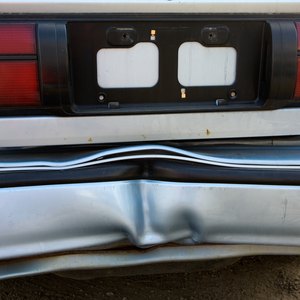
Bumper damage is commonly covered by auto insurance, but you must have the proper coverage in order for your insurance company to pick up the tab. Even if your policy does cover whatever caused the damage to your bumper, there are other matters to consider before filing a claim, including the amount of damage to your bumper and the cost of its repair.
Source of Damage
Whether or not your bumper damage can be claimed on your insurance depends on what caused the damage and the type of coverage included in your policy. If your bumper was the result of a car accident, it will be covered if your policy includes collision coverage. If the bumper was damaged by another event, such as vandalism or a tree falling on it, it will not be covered unless you have comprehensive coverage.
Damage Covered by Collision Insurance
Collision coverage specifically covers damage to a vehicle that is the result of an auto accident. For example, if you were rear ended while idling at a stoplight, the bumper damage caused by the impact would be covered under your policy because it happened during a traffic accident, provided you have collision coverage. Generally, collision coverage pays repair and replacement costs, including damage that results from a car rolling over. Insurance companies often require a driver to have both collision and comprehensive coverage in order to include collision coverage on an insurance policy. This is also required by many lenders as a condition of vehicle financing.
Damage Covered by Comprehensive Insurance
If the damage to your bumper was caused by something other than a traffic accident, your insurance company will not pay for the damages unless you have comprehensive coverage on your policy. Comprehensive coverage pays for damage caused by such events as vandalism, natural disasters, theft, road debris, fire, or even hitting animals.
Effect of Deductible
With either type of coverage, you will first have to pay your deductible before your insurance company will pay the remaining repair or replacement costs. When you sign up for insurance, you choose a deductible you're comfortable with. The higher the deductible, the lower the overall cost of your insurance plan and monthly payments. A higher deductible also means that your out-of-pocket costs will be larger if you later have to file a damage claim. For example, if your bumper costs $1,200 to repair and your deductible is $1,000, you'll have to contribute $1,000 toward repair costs and your insurance company will only foot the remaining $200 balance. Filing any claim can have consequences on costs of your coverage, so you must weigh the pros and cons of filing versus paying the whole bill out of your pocket.
References
- Geico: Auto Insurance Coverage
- 21st Century Insurance: Understanding Car Insurance Deductibles
- Progressive. "Full Coverage Car Insurance." Accessed June 19, 2020.
- Insurance Information Institute. "Auto Insurance Basics—Understanding Your Coverage." Accessed June 19, 2020.
- Nationwide. "What Is Full Coverage Auto Insurance?" Accessed June 19, 2020.
- Allstate. "What Is 'Full Coverage'?" Accessed June 19, 2020.
- Progressive. "What Is Gap Insurance?" Accessed June 19, 2020.
- Allstate. "Roadside Assistance Frequently Asked Questions." Accessed June 19, 2020.
- State Farm. "Replacement Parts." Accessed June 19, 2020.
- Allstate. "Does Car Insurance Cover Windshield Damage?" Accessed June 19, 2020.
- Nationwide. "Vanishing Deductible." Accessed June 19, 2020.
Writer Bio
Based on the West Coast, Mary Jane Freeman has been writing professionally since 1994, specializing in the topics of business and law. Freeman's work has appeared in a variety of publications, including LegalZoom, Essence, Reuters and Chicago Sun-Times. Freeman holds a Master of Science in public policy and management and Juris Doctor. Freeman is self-employed and works as a policy analyst and legal consultant.

